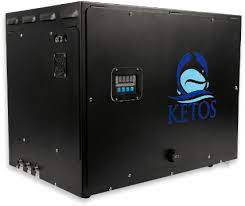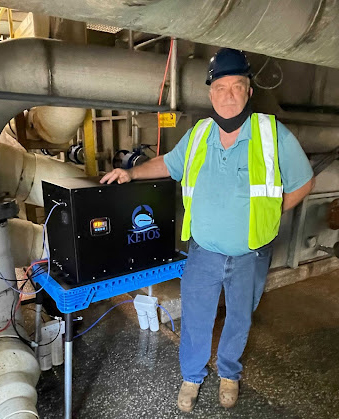Remotely Measure Levels of Zinc in Water
Monitoring Water for Zinc With KETOS SHIELD
Water operators across industries need an automated solution that can offer lab-accurate monitoring across their required water testing parameters – including zinc.
Accurately Measure Levels of Zinc in Water
Download our KETOS SHIELD overview to learn how:
- Users can monitor for 30+ water parameters
- Users have access to live data and can customize user-triggered thresholds to enable real-time decision-making
- Our system eliminates the need for multiple analyzers, manual processing, and third-party modeling, saving time, labor, and data science costs
- Our technology continuously provides water operators with EPA-compliant and lab-accurate information (in ppb)
Learn To Automate Zinc Testing In Water With Lab-Accurate Results in Real-Time
"*" indicates required fields
Testing for Zinc in Water
 KETOS SHIELD allows for the monitoring of all required water testing parameters. Sampling happens in real-time and lowers up-front costs with an industry-leading $0-CAPEX subscription model.
Leverage the latest in AI, IoT, big data, and automation technology with KETOS SHIELD. From one device, operators get real-time data on zinc levels and 30+ other water testing parameters (such as environmental factors, heavy metals, and more). Monitoring happens within a cloud-enabled modular system that allows for safe, easy 24/7 access.
KETOS SHIELD allows for the monitoring of all required water testing parameters. Sampling happens in real-time and lowers up-front costs with an industry-leading $0-CAPEX subscription model.
Leverage the latest in AI, IoT, big data, and automation technology with KETOS SHIELD. From one device, operators get real-time data on zinc levels and 30+ other water testing parameters (such as environmental factors, heavy metals, and more). Monitoring happens within a cloud-enabled modular system that allows for safe, easy 24/7 access.
Why Monitor Water for Zinc with KETOS
Zinc is a common element in the air, water, and food. As a micronutrient, humans need to ingest zinc in small quantities. However, more significant amounts may cause health issues. When zinc is found at higher levels in water, clarity and taste are affected. Zinc sometimes enters water supplies after being stored in metal containers coated with zinc or if water passes through a coated pipe that uses zinc to resist corrosion. Since zinc can affect water quality (in both clarity and taste), it’s a vital parameter to test for in municipal drinking water systems and in food and beverage applications. Controlling zinc levels allows for better quality control and a more predictable product.What are the Issues with Zinc in Water?
 KETOS provides advanced water quality monitoring for zinc, using real-time data and intelligent sensors to detect and manage contamination levels, ensuring safety and regulatory compliance.
KETOS provides advanced water quality monitoring for zinc, using real-time data and intelligent sensors to detect and manage contamination levels, ensuring safety and regulatory compliance.- Health Risks: Elevated levels of zinc in drinking water can pose health risks to humans, particularly through chronic exposure. Excessive zinc intake can lead to gastrointestinal issues such as nausea, vomiting, and diarrhea. Prolonged exposure to high levels of zinc may also impair immune function, disrupt metabolic processes, and lead to adverse health effects such as copper deficiency and neurological symptoms.
- Environmental Impact: Zinc pollution in water bodies can have detrimental effects on aquatic ecosystems and biodiversity. Elevated zinc levels can accumulate in sediments and water column, posing toxicity risks to aquatic organisms such as fish, invertebrates, and algae. Zinc toxicity can impair reproduction, growth, and survival of aquatic species, leading to population declines and ecological imbalances.
- Corrosion and Infrastructure Damage: Zinc can contribute to corrosion in metal pipes, plumbing fixtures, and infrastructure in water distribution systems. Corrosion-related issues can lead to leaks, pipe failures, and infrastructure damage, compromising the integrity and reliability of water supply networks. Managing zinc levels in water sources is essential for minimizing corrosion-related maintenance costs and infrastructure degradation.
- Industrial Discharges: Industrial activities such as metal plating, galvanizing, and mining can release zinc into water bodies through wastewater discharges and runoff. Elevated zinc concentrations in industrial effluents can contribute to zinc pollution in receiving water bodies, leading to environmental contamination and potential ecological impacts. Implementing pollution prevention measures and wastewater treatment technologies is essential for mitigating zinc pollution from industrial sources.
- Regulatory Compliance: Governments and regulatory agencies establish guidelines and standards for zinc levels in drinking water and aquatic ecosystems to protect public health and the environment. Compliance with these regulations requires industries, municipalities, and other stakeholders to monitor zinc concentrations regularly, implement mitigation measures to minimize zinc inputs, and adhere to zinc-related restrictions and guidelines.
- Water Treatment Challenges: Removing zinc from water sources can be challenging due to its chemical properties and solubility. Conventional water treatment methods such as coagulation, sedimentation, and filtration may be insufficient for zinc removal. Advanced treatment technologies such as ion exchange, adsorption, and membrane filtration may be required to reduce zinc concentrations to acceptable levels.
Causes of Zinc in Water
Zinc in water can originate from both natural and human sources. Naturally, zinc is present in the Earth’s crust, and weathering of zinc-containing rocks and minerals can release it into water bodies. Additionally, zinc can leach into water from soil and sediment, particularly in areas with high zinc concentrations in geological formations. Human activities significantly contribute to zinc contamination in water. Industrial processes such as mining, metal production, and electroplating release zinc into water as wastewater effluents. Urban runoff, sewage discharges, and agricultural practices such as the use of zinc-containing pesticides and fertilizers also contribute to zinc levels in water. While zinc is an essential micronutrient for biological functions, elevated concentrations in water can be toxic to aquatic life and humans. Therefore, effective management of sources and levels of zinc in water is essential for protecting water quality and ecosystem health.Acceptable Levels of Zinc in Water by Industry
Zinc is a common contaminant in water sources, and its concentration must be carefully regulated to ensure safety across various industries. Acceptable levels of zinc in water vary depending on its intended use. In the agricultural sector, where irrigation water quality is critical for crop health, the permissible concentration typically ranges from 0.1 to 1 milligrams per liter (mg/L). Industrial applications such as metal finishing and electroplating require stricter controls, with acceptable zinc levels usually maintained below 0.1 mg/L to prevent corrosion and maintain product quality. Similarly, in drinking water, the allowable zinc concentration is set at a maximum of 5 mg/L by regulatory bodies like the Environmental Protection Agency (EPA) to safeguard public health. Proper monitoring and adherence to these standards are essential to mitigate environmental risks and ensure the safety of water resources.| Industry | Acceptable Zinc Levels (mg/L) |
|---|---|
| Agriculture (irrigation) | 0.1 – 1 |
| Industrial (metal finishing, electroplating) | Below 0.1 |
| Drinking Water (EPA standard) | Up to 5 |
How to Easily Monitor Water for Zinc
Instead of measuring zinc with a meter that only measures a handful of conditions; the KETOS SHIELD is capable of mentoring dozens of water related issues — in real-time. With KETOS, monitor zinc levels in your water and so much more. Our device offers coverage of dozens of water testing parameters to make it easy to get a holistic understanding of your water quality based on your company’s own unique requirements. If you need to detect cadmium in groundwater, assess arsenic levels in well water or analyze calcium in open field agriculture, KETOS’ automated water monitoring system is the solution you need. By incorporating calcium detection capabilities for open field agriculture applications, it offers an efficient means to ensure water quality, save time, and address regulatory concerns across diverse sectors.What Water Quality Parameter Do You Test Most Often?
The KETOS SHIELD remotely monitors dozens of water quality parameters. Which one do your water operators test most often?
KETOS Awards
















About KETOS
KETOS is a fully integrated platform that combines hardware, software, connectivity, automated reporting, predictive analytics, and maintenance to automate water monitoring and testing. KETOS enables water operators to identify and solve mission-critical water efficiency and quality challenges in real-time, or before they happen through predictive algorithms, to ensure that water meets specific quality and safety standards.
Copyright © – KETOS.co

